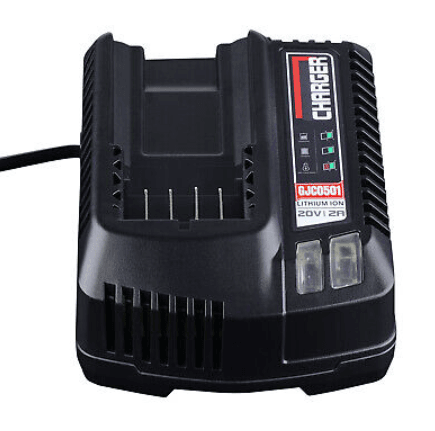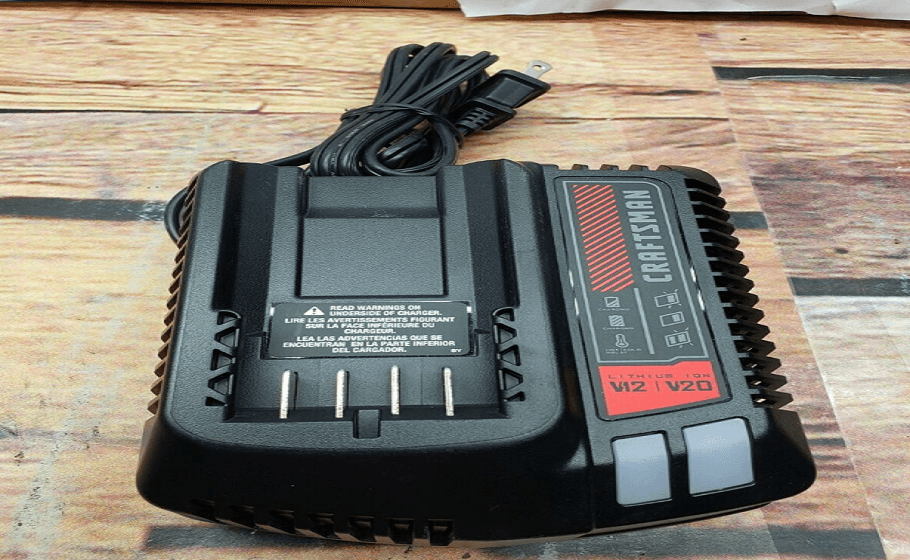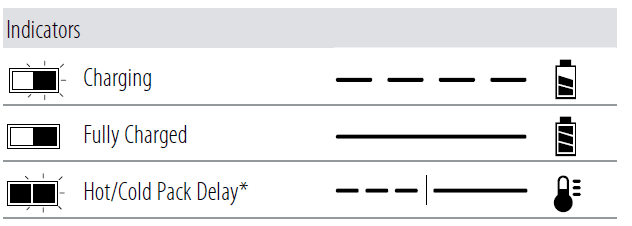
Craftsman CMCB100 20V Lithium Ion Battery Charger

Important Safety Instructions for All Battery Chargers
WARNING: Read all safety warnings, instructions, and cautionary markings for the battery pack, charger, and product. Failure to follow the warnings and instructions may result in electric shock, fire, and/or serious injury.
- DO NOT attempt to charge the battery pack with any chargers other than the ones in this manual. The charger and battery pack are specifically designed to work together.
- These chargers are not intended for any use other than charging CRAFTSMAN rechargeable batteries. Any other uses may result in a risk of fire, electric shock, or electrocution.
- Do not expose the charger to rain or snow.
- Pull by the plug rather than the cord when disconnecting the charger. This will reduce the risk of damage to the electric plug and cord.
- Make sure that the cord is located so that it will not be stepped on, tripped over, or otherwise subjected to damage or stress.
- Do not use an extension cord unless it is absolutely necessary. Use of improper extension cords could result in a risk of fire, electric shock,k or electrocution.
- When operating a charger outdoors, always provide a dry location and use an extension cord suitable for outdoor use. The use of a cord suitable for outdoor use reduces the risk of electric shock.
- An extension cord must have adequate wire size (AWG or American Wire Gauge) for safety. The smaller the gauge number of the wire, the greater the capacity of the cable, that is, 16 gauge has more capacity than 18 gauge. An undersized cord will cause a drop in line voltage resulting in loss of power and overheating. When using more than one extension to make up the total length, be sure each extension contains at least the minimum wire size. The following table shows the correct size to use depending on cord length and nameplate ampere rating. If in doubt, use the next heavier gauge. The lower the gauge number, the heavier
the cord. - Minimum Gauge for Cord Sets
| Volts | Total length of Cord in Feet (meters) | ||||
| 120 V | 25 (7.6) | 50 (15.2) | 100 (30.5) | 150 (45.7) | |
| 240 V | 50 (15.2) | 100 (30.5) | 200 (61.0) | 300 (91.4) | |
| Ampere Rating | American Wire gauge | ||||
| More Than | not More Than | ||||
| 0 | 6 | 18 | 16 | 16 | 14 |
| 6 | 10 | 18 | 16 | 14 | 12 |
| 10 | 12 | 16 | 16 | 14 | 12 |
| 12 | 16 | 14 | 12 | Not Recommended | |
- Do not place any object on top of the charger or place the charger on a soft surface that might block the ventilation slots and result in excessive internal heat. Place the charger in a position away from any heat source. The charger is ventilated through slots in the top and the bottom of the housing.
- Do not operate the charger with a damaged cord or plug.
- Do not operate the charger if it has received a sharp blow, been dropped, or otherwise damaged in any way. Take it to an authorized service center.
- Do not disassemble the charger; take it to an authorized service center when service or repair is required. Incorrect reassembly may result in a risk of electric
shock, electrocution, or fire. - Disconnect the charger from the outlet before attempting any cleaning. This will reduce the risk of electric shock. Removing the battery pack will not reduce
this risk. - NEVER attempt to connect 2 chargers together.
- The charger is designed to operate on standard 120V household electrical power. Do not attempt to use it on any other voltage.
- WARNING: Shock hazard. Do not allow any liquid to get inside the charger. Electric shock may result.
- NOTICE: Under certain conditions, with the charger plugged into the power supply, the charger can be shorted by foreign material. Foreign materials of a conductive nature, such as, but not limited to, grinding dust, metal chips, steel wool, aluminum foil or any buildup of metallic particles should be kept away from the charger cavities. Always unplug the charger from the power supply when there is no battery pack in the cavity. Unplug the charger before attempting to clean it.
Charging a Battery
NOTE: To ensure maximum performance and life of lithium-ion battery packs, charge the battery pack fully before first use.
- Plug the charger into an appropriate outlet before inserting the battery pack.
- Connect the charger and battery pack, making sure the battery is fully seated. The (charging) light will blink continuously indicating that the charging process
has started. - The completion of the charge will be indicated by the light remaining ON continuously. The battery pack is fully charged and may be removed and used at this time or left in the charger.
- NOTE: To remove the battery pack, some chargers require the battery pack release button to be pressed.

- The compatible charger(s) will not charge a faulty battery pack. The charger will indicate a faulty battery pack by refusing to light.
- NOTE: This could also mean a problem with a charger. If the charger indicates a problem, take the charger and battery pack to be tested at an authorized service center.
- Hot/Cold Pack Delay
- When the charger detects a battery pack that is too hot or too cold, it automatically starts a Hot/Cold Pack Delay, suspending charging until the battery pack has reached an appropriate temperature. The charger then automatically switches to the pack charging mode. This feature ensures maximum battery pack life. A cold battery pack may charge at a slower rate than a warm battery pack.
- NOTE: To remove the battery pack, some chargers require the battery pack release button to be pressed.
Important Charging Notes
- The longest life and best performance can be obtained if the battery pack is charged at a temperature between 65 °F and 75 °F (18 ° – 24 °C). DO NOT charge when the battery is below +40 °F (+4.5 °C), or above +104 °F (+40 °C). This is important and will prevent serious damage to the battery pack.
- The charger and battery pack may become warm to the touch while charging. This is a normal condition and does not indicate a problem. To facilitate the cooling of the battery pack after use, avoid placing the charger or battery pack in a warm environment such as in a metal shed or an uninsulated trailer.
- If the battery pack does not charge properly:
- a. Check the operation of the receptacle by plugging in a lamp or other appliance;
- b. Check to see if the receptacle is connected to a light switch which turns the power off when you turn out the lights;
- c. Move the charger and battery pack to a location where the surrounding air temperature is approximately 65 °F – 75 °F (18 ° – 24 °C);
- d. If charging problems persist, take the tool, battery pack, and charger to your local service center.
- The battery pack should be recharged when it fails to produce sufficient power on jobs that were easily done previously. DO NOT CONTINUE to use under these
conditions. Follow the charging procedure. You may also charge a partially used pack whenever you desire with no adverse effect on the battery pack. - Foreign materials of a conductive nature such as, but not limited to, grinding dust, metal chips, steel wool, aluminum foil, or any buildup of metallic particles should be kept away from charger cavities. Always unplug the charger from the power supply when there is no battery pack in the cavity. Unplug the charger before attempting to clean it.
- Do not freeze or immerse the charger in water or any other liquid.
Charger Cleaning Instructions
- WARNING: Shock hazard. Disconnect the charger from the AC outlet before cleaning. Dirt and grease may be removed from the exterior of the charger using a cloth or soft non-metallic brush. Do not use water or any cleaning solutions.
- Wall Mounting
- These chargers are designed to be wall mountable or to sit upright on a table or work surface. If wall mounting, locate the charger within reach of an electrical outlet, and away from a corner or other obstructions which may impede airflow. Use the back of the charger as a template for the location of the mounting screws on the wall. Mount the charger securely using drywall screws (purchased separately) at least 1″ (25.4 mm) long, with a screw head diameter of 0.28″–0.35″ (7–9 mm), screwed into wood to an optimal depth leaving approximately 7/32″ (5.5 mm) of the screw exposed. Align the slots on the back of the charger with the exposed screws and fully engage them in the slots. CRAFTSMAN chargers can be mounted to the wall using CRAFTSMAN VersaTrack Trackwall. Hooks and accessories are sold separately. Please refer to the VersaTrack Trackwall accessory sheet for further information.
READ ALL INSTRUCTIONS
Important Safety Instructions for All Battery Packs
- Do not charge or use the battery pack in explosive atmospheres, such as in the presence of flammable liquids, gases, or dust. Inserting or removing the battery pack from the charger may ignite the dust or fumes.
- NEVER force the battery pack into the charger. DO NOT modify the battery pack in any way to fit into a non-compatible charger as the battery pack may rupture causing serious personal injury. Consult the chart at the end of this manual for compatibility of batteries and chargers.
- Charge the battery packs only in CRAFTSMAN chargers.
- DO NOT splash or immerse in water or other liquids.
- Do not store or use the tool and battery pack in locations where the temperature may reach or exceed 104 °F (40 °C) (such as outside sheds or metal buildings
in summer). For best life store battery packs in a cool, dry location. - NOTE: Do not store the battery packs in a product with the trigger switch locked on. Never tape the trigger switch in the ON position.
- Do not incinerate the battery pack even if it is severely damaged or is completely worn out. The battery pack can explode in a fire. Toxic fumes and materials are created when lithium-ion battery packs are burned.
- If battery contents come into contact with the skin, immediately wash the area with mild soap and water. If battery liquid gets into the eye, rinse water over the open eye for 15 minutes or until irritation ceases. If medical attention
Storage Recommendations
- The best storage place is one that is cool and dry, away from direct sunlight and excess heat or cold.
- For long storage, it is recommended to store a fully charged battery pack in a cool dry place out of the charger for optimal results.
- NOTE: Battery packs should not be stored completely depleted of charge. The battery pack will need to be recharged before use.
The RBRC® Seal
- The RBRC® (Rechargeable Battery Recycling Corporation) Seal on the lithium-ion batteries (or battery packs) indicates that the costs to recycle these batteries (or battery packs) at the end of their useful life have already been paid by CRAFTSMAN. In some areas, it is illegal to place spent lithium-ion batteries in the
trash or municipal solid waste stream and the Call 2 Recycle® program provides an environmentally conscious alternative. - Transportation
- WARNING: Fire hazard. Do not store or carry the battery pack so that metal objects can contact exposed battery terminals. For example, do not place the battery pack in aprons, pockets, tool boxes, product kit boxes, drawers, etc., with loose nails, screws, keys, etc.
- Transporting batteries can possibly cause fires if the battery terminals inadvertently come in contact with conductive materials such as keys, coins, hand tools, and the like. The US Department of Transportation Hazardous Material Regulations (HMR) actually prohibit transporting batteries in commerce or on airplanes in carry-on baggage UNLESS they are properly protected from short circuits. So when transporting individual battery packs, make sure that the battery terminals are protected and well-insulated from materials that could contact them and cause a short circuit
MAINTENANCE
Repairs
- The charger and battery pack are not serviceable. There are no serviceable parts inside the charger or battery pack.
- WARNING: To assure product SAFETY and RELIABILITY, repairs, maintenance, and adjustment (including brush inspection and replacement, when applicable) should be performed by a CRAFTSMAN factory service center or a CRAFTSMAN authorized service center. Always use identical replacement parts.
Register Online
Thank you for your purchase. Register your product now for:
- WARRANTY SERVICE: Registering your product will help you obtain more efficient warranty service in case there is a problem with your product.
- CONFIRMATION OF OWNERSHIP: In case of an insurance loss, such as fire, flood, or theft, your registration of ownership will serve as your proof of purchase.
- FOR YOUR SAFETY: Registering your product will allow us to contact you in the unlikely event a safety notification is required under the Federal Consumer Safety Act. Register online at www.craftsman.com/registration
For more manuals by Craftsman visit, ManualsLibraryy
Craftsman CMCB100 20V Lithium Ion Battery Charger-FAQs
How long does it take to charge a 20V lithium battery?
Charging time depends on the type of charger. A standard charger may take several hours, while a fast charger can fully charge a battery in about 30 minutes.
Why is the red light on my Craftsman V20 charger blinking?
1. Solid red light: Battery is fully charged.
2. Long-short blinking: Battery is too hot or too cold.
3. Fast blinking: Battery pack may need replacement.
4. Fast double blinking: Power supply issue.
Can I leave my Craftsman battery on the charger?
It is not recommended to leave the battery on the charger for extended periods, as it may reduce battery lifespan and increase self-discharge over time.
How do I know when my battery is fully charged?
Most Craftsman chargers have an indicator light that turns solid green when the battery is fully charged. If your charger lacks an indicator, refer to the user manual for confirmation.
How long do Craftsman V20 batteries last?
Battery life varies based on tool demand and usage. A 4.0Ah battery typically provides about one hour of continuous use per charge.
Why is my Craftsman battery charger blinking green?
A blinking green light means the battery is currently charging. Once it is fully charged, the light will turn solid green.
Why is my lithium battery blinking green?
The blinking green LED indicates that the battery is still charging. Once it is fully charged, the LED will remain solid green.
How long does the Craftsman 20V string trimmer battery last?
Independent testing shows a runtime of approximately 35 minutes per charge.
How do I check if a lithium battery is fully charged?
A fully charged lithium battery typically reads 13.6V at rest. A 99% charged battery reads 13.4V, and a 93% charged battery reads 13.3V.
Is it bad to charge a lithium-ion battery to 100%?
Charging to 100% can shorten battery lifespan. To prolong its life, it’s recommended to maintain charge levels between 25% and 85% and avoid overcharging, which can pose safety risks.


